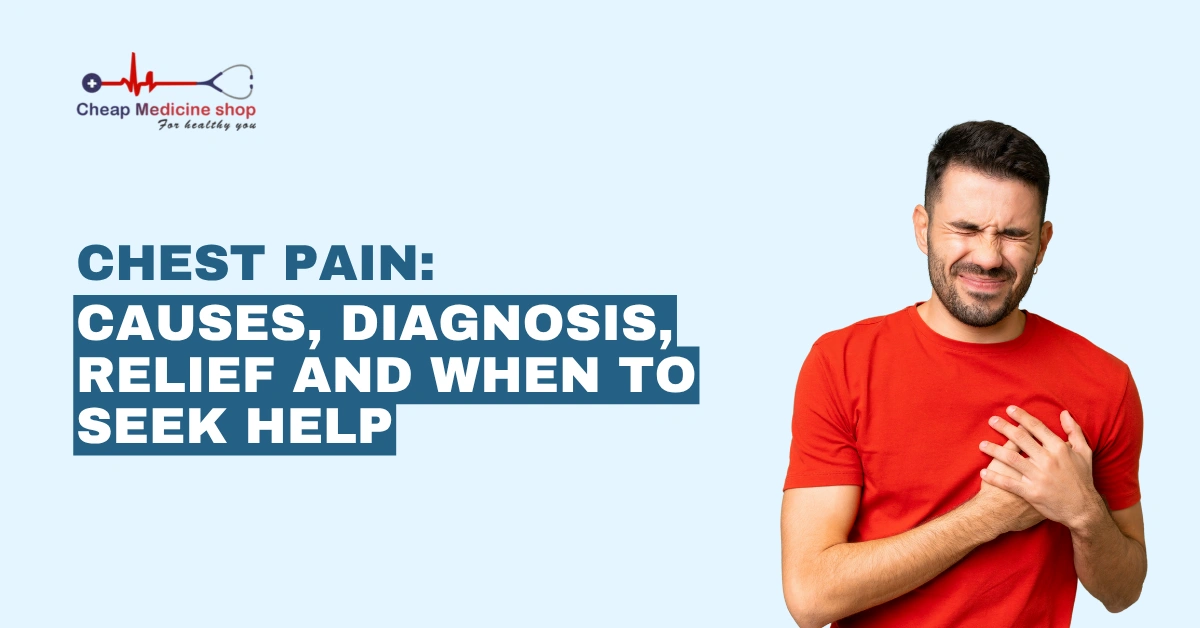Chest pain can feel scary, but it is not always something to worry about. Around 7 million people in the US visit emergency departments yearly with chest pain complaints, yet many turn out not to have heart problems.
It is essential to understand that it’s not the same for all. Some people feel a heavy pressure, others a sharp stab. For some, it’s on one side, but others may feel it on both sides, or it may come and go unpredictably.
Sometimes it’s a sign of something serious, other times it’s mild and resolves quickly. The key is to determine when it’s alarming and you need medical attention.
This article will explain what chest pain is, its key symptoms, common causes, and when to seek medical help to ensure safety. It will also cover how doctors diagnose it, treatment, and prevention tips, so you can act promptly when it happens.
What is chest pain?
It is any uncomfortable or abnormal sensation, discomfort, or pain in your chest region. It can be dull, sharp, burning, aching, or tight. Everyone experiences it differently.
Some experience right-sided chest pain when there is an issue with the lungs, ribs, or digestive organs. Others feel pain on the left side when the heart or esophagus (food pipe) is involved. The chest pain that comes and goes usually reflects unstable or episodic conditions like Angina or acid reflux spasms.
Pain may also spread to your jaw, back, arms, or neck. Understanding how and when it appears helps narrow down its origin.
Save up to 90% on your medicine bills

Angispan TR 2.5 Mg

Imdur 60 Mg

Olmesar A 5+20 Mg

Lobet 100 Mg
Other symptoms associated with chest pain
Before finding the causes, it is essential to recognize the common accompanying symptoms. These often guide clinicians in distinguishing between severe and mild causes.
You may notice one or more of the following:
- Shortness of breath or difficulty breathing
- Sweating (cold sweat)
- Nausea or vomiting
- Lightheadedness or dizziness
- Palpitations or a racing heart
- Persistent cough, fever, or chills
- Pain that worsens with movement, breathing, or pressure
- Indigestion, bloating, and burping
These signals, combined with how the pain behaves, help doctors decide what’s going on.
Causes of chest pain
Many conditions can produce chest discomfort. Some of the common causes include:
Cardiac causes
When the heart or its vessels are involved, chest pain may result from reduced blood supply, inflammation, or structural damage. Some of the key causes include:
- Angina (chest pain caused by reduced blood flow)
- Ischemic heart disease (inadequate oxygen and blood supply to the heart)
- Acute Myocardial Infarction (heart attack)
- Pericarditis (inflammation of the heart’s lining)
- Aortic dissection (a tear in the aorta)
- Cardiomyopathy (heart muscle disease) or valve diseases
Respiratory causes
Problems in the lungs or their lining can cause chest pain, particularly when breathing or coughing. Examples are:
- Pleurisy/Pleuritis (inflammation of the lining of the lungs)
- Pulmonary Embolism (blood clot in the lung)
- Pneumonia (a lung infection)
- Pneumothorax (collapsed lung)
- Bronchitis (inflammation of the airway in the lungs) or an Asthma flare
Gastrointestinal (GI) causes
The esophagus and digestive tract are located close to the chest. So, any pain or issues related to them can often be mistaken for chest pain or cause it. These may include:
- Gastroesophageal Reflux Disease (GERD)
- Esophageal spasm or motility disorder
- Esophagitis (inflammation of the esophagus) or ulcer
- Gallbladder pain
- Gas pain in the chest (from bloating)
- Post‑meal indigestion
Musculoskeletal causes
Injury or inflammation in muscles, bones, or cartilage can cause chest pain. Some of the examples are:
- Chest muscle strain
- Costochondritis (rib cartilage inflammation)
- Rib fracture or trauma
- Chest wall muscle tightness or spasm
Other causes
Emotional or systemic issues can also produce chest discomfort. These include:
- Panic attacks or Anxiety
- Hyperventilation Syndrome (breathing too quickly or deeply)
- Dehydration
- Referred pain (pain in a different location than its origin)
- Shingles (a viral infection that causes a painful rash) if nerve irritation is involved
- Esophageal rupture, which is rare but serious
Risk factors
There are factors that increase the likelihood of a cause that results in pain or raise the danger level of chest pain. Some of them include:
- Increasing age
- Family history of heart or vascular disease
- High Blood Pressure
- High cholesterol
- Diabetes
- Smoking
- Obesity or lack of exercise
- Longtime GERD or Hiatal Hernia (Stomach Hernia)
- Autoimmune disease
- Previous cardiac events or interventions
- Excessive use of alcohol or Non-steroidal Anti-inflammatory Drugs (NSAIDs)
- Chronic stress
How is chest pain diagnosed?
Doctors use a structured approach to pinpoint the cause of pain. First, they gather a detailed history, including when the pain started and what events triggered or relieved it. They may also evaluate how long it lasts, where it spreads, and what symptoms accompany it.
It is followed by a physical exam, where vital signs (blood pressure, heart rate, oxygen levels) are checked. The doctor listens to the heart and lungs for abnormal sounds. Pressing on the chest wall can reveal tenderness, which hints toward a musculoskeletal origin.
If needed, imaging or advanced tests follow, such as:
- Chest X‑ray to evaluate lungs, bones, and structures.
- CT angiography for suspected vascular issues (blood vessel issues).
- An echocardiogram is used to see how blood is moving through the heart and valves.
- An Electrocardiogram (ECG) records the heart’s electrical activity to detect Ischemia (reduced blood flow) or Arrhythmias (irregular heartbeat).
- Blood tests or cardiac biomarkers, such as Troponin, are used to assess whether there is injury to the heart muscle.
- Endoscopic or motility studies are performed if GI causes are suspected.
- Stress testing or coronary angiography is recommended when heart disease remains a possibility.
Finally, the doctor combines all data to decide whether you can go home safely, need tests, or require hospital admission. Each of these steps is aimed at ruling out life‑threatening causes first, then targeting milder ones.
Treatment and management
Treatment depends entirely on the cause. Here’s how medical care approaches different origins, and what you can do for relief in the meantime.
In cardiac causes
When tests confirm a heart origin, it usually requires hospitalization. Medications such as antiplatelet agents, anticoagulants, and statins are prescribed to prevent blood clotting and reduce cholesterol levels.
For severe cases, interventions such as angioplasty (opening or widening blocked arteries) and bypass surgery (using healthy blood vessels from another part of the body to create a new path around blocked arteries) are used. Cases like artery rupture can require emergency surgery.
After stabilization, long-term therapy focuses on preventing recurrence with lifestyle changes and medicines.
In noncardiac causes
In cases when there is no involvement of the heart, the treatment and management will differ for each cause. It is typically a combination of at-home care and medication. General treatments include:
For lung or respiratory causes
When respiratory factors are involved, the focus is on treating the underlying issues. Infections are treated with antibiotics, such as Azithromycin. A doctor may prescribe anticoagulants for blood clots if needed. Bronchodilators or steroids are prescribed for airway disease as they provide oxygen support.
For GERD or esophageal causes
Doctors usually prescribe Proton Pump Inhibitors (PPIs) or Histamine-2 (H2) blockers for relief. You should eat smaller meals, avoid trigger foods, such as fatty or spicy foods, and avoid lying flat soon after eating.
For musculoskeletal pain
You should rest, apply heat or a cold compress, and try gentle stretching or physical therapy if you have chest muscle pain. If needed and safe, a doctor can prescribe painkillers like Naproxen.
For gas or bloating
To reduce gas pain in the chest, modify your diet by chewing food thoroughly and eating smaller meals. Over-the-counter options, such as Simethicone, can also help ease gas-related pain.
For Anxiety or stress
The treatment involves breathing exercises, cognitive behavioral therapy, and relaxation methods. Medications like Benzodiazepines (for short-term) or beta-blockers are prescribed for stress or Anxiety under supervision when needed.
For cough‑induced pain
You can address the cough with decongestants or prescribed therapies, such as cough syrups or tablets. Ensure to rest and support your chest during coughing.
For dehydration
You should rehydrate with fluids and correct electrolyte imbalances. If needed, seek medical help for guidance.
How to prevent chest pain?
You can reduce your chances of experiencing chest pain by addressing its underlying causes or triggers. To prevent pain, you should try to:
- Control blood pressure, cholesterol, and blood sugar.
- Follow a balanced, nutrient-rich diet and maintain a healthy weight.
- Quit smoking and alcohol.
- Engage in regular, doctor‑approved physical activity (avoid when rest is advised).
- Avoid overstraining your chest muscles.
- Get routine checkups if you have risk factors.
When to see a doctor for chest pain?
You should see a doctor immediately if you:
- Notice pain in the jaw, arms, or back.
- Have unexplained sudden pain.
- Experience worsening pain or symptoms, such as shortness of breath, nausea, or sweating.
- Have pre-existing heart conditions or a family history of cardiovascular issues.
- Experience recurrent pain or discomfort that increases with activity.
Conclusion
Chest pain refers to the discomfort or ache experienced in the chest region. It may stem from your heart, lungs, digestive system, muscles, or even stress.
Some additional symptoms you can experience are pressure, tightness, burning, nausea, or lightheadedness. These are often assessed to evaluate the underlying cause.
With proper diagnosis, many causes can be treated with medications such as anticoagulants or managed through a balanced diet, adequate hydration, and regular physical activity. Preventive steps like quitting smoking and routine checkups can help reduce risk.
However, when in doubt, seek timely medical attention. Early diagnosis and care can minimize harm and protect your health.
Frequently Asked Questions
What to drink for chest pain?
For mild chest discomfort or pain, try drinking warm herbal tea, such as chamomile or ginger, or plain water. They can help ease discomfort, mainly if it’s caused by indigestion. Avoid caffeine, carbonated drinks, or acidic juices until the cause is clear. However, if you have severe pain, seek medical guidance.
How to sleep with chest pain?
If you experience chest pain, try sleeping with your upper body elevated using pillows or an adjustable bed. Avoid lying flat immediately after eating. Choose positions that reduce strain on the chest, such as the back or a slight left side.
Is coffee bad for chest pain?
Yes, caffeine present in coffee may worsen reflux or palpitations. So, avoiding coffee during pain episodes is wise. Once you know the cause, your doctor can advise whether moderate caffeine is acceptable.
Can chest pain wake you up at night?
Yes, acid reflux often flares when lying flat, causing chest discomfort that wakes you. Also, unstable Angina may present nocturnally (at night) in some heart patients. If you experience trouble sleeping due to pain, you should seek medical help.
Is my heart okay if my ECG is normal?
No, a normal ECG does not necessarily point to a healthy heart. Some problems do not show up in a single ECG, while sometimes it may not catch an active heart attack. If you experience discomfort or symptoms, such as sharp chest pain or shortness of breath, seek thorough testing.
Cheap Medicine Shop only refers to credible, authoritative sources for our content. If you’re curious about how we ensure the integrity of our content, we encourage you to read our Content Information Policy.














